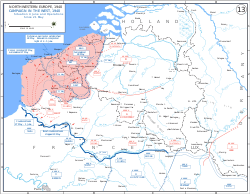
Back Schlacht um Boulogne German Boulognen taistelu Finnish Siège de Boulogne-sur-Mer (1940) French Slag om Boulogne Dutch Batalha de Bolonha (1940) Occitan Obrona Boulogne (1940) Polish Batalha de Boulogne Portuguese Bătălia de la Boulogne (1940) Romanian ยุทธการที่บูลอญ (ค.ศ. 1940) Thai Trận Boulogne (1940) Vietnamese
| Battle of Boulogne (1940) | |||||||
|---|---|---|---|---|---|---|---|
| Part of Battle of France | |||||||
 The Battle of France, situation 21 May – 4 June 1940 | |||||||
| |||||||
| Belligerents | |||||||
|
|
| ||||||
| Commanders and leaders | |||||||
|
|
| ||||||
| Strength | |||||||
|
1,500 Auxiliary Military Pioneer Corps troops supporting units | 1 panzer division | ||||||
| Casualties and losses | |||||||
| c. 5,000 POW | |||||||
The Battle of Boulogne in 1940 was the defence of the port of Boulogne-sur-Mer by French, British and Belgian troops in the Battle of France during the Second World War. The battle was fought at the same time as the Siege of Calais, just before Operation Dynamo, the evacuation of the British Expeditionary Force (BEF) from Dunkirk. After the Franco-British counter-attack at the Battle of Arras on 21 May, German units were held ready to resist a resumption of the attack on 22 May. General der Panzertruppe (Lieutenant-General) Heinz Guderian, the commander of XIX Corps, protested that he wanted to rush north up the Channel coast to capture Boulogne, Calais and Dunkirk. An attack by part of XIX Corps was not ordered until 12:40 p.m. on 22 May, by which time the Allied troops at Boulogne had been reinforced from England by most of the 20th Guards Brigade.
The Guards had time to dig in around the port before the 2nd Panzer Division, which had been delayed by French troops at Samer, attacked the perimeter held by the Irish Guards at around 5:00 p.m. and were driven off after an hour of fighting. The Welsh Guards front was attacked at 8:00 p.m. and again at dusk, cutting off a party of the Irish at 10:00 p.m. At dawn on 23 May, the German attacks resumed, eventually pushing the defenders back into the town. About eighty light bombers of the Royal Air Force (RAF) flew sorties in support of the defenders of the port.
Royal Navy ships shot their way into and out of the harbour; French and British destroyers bombarded German positions as wounded and non-combatants were embarked and a navy demolition party landed. During a lull in the afternoon of 23 May, the Luftwaffe bombed the harbour, despite being intercepted by RAF fighters. At 6:30 p.m. the Guards Brigade was ordered to re-embark; the British destroyers ran the gauntlet of German tanks and artillery to dock. The French defenders above the lower town could not be contacted and only in the morning of 24 May did General Lanquetot realise that the British had gone.
The French and the remaining British troops held out until 25 May and then surrendered. Guderian wrote that the halt order and the retention of considerable forces to guard against Allied counter-attacks, forfeited an opportunity quickly to capture the Channel Ports and destroy the Allied forces in northern France and Belgium. An advance on Dunkirk began on 23 May but the next day was halted until 27 May; Dunkirk was not captured until 4 June, by when, most of the BEF and many French and Belgian troops had escaped.
© MMXXIII Rich X Search. We shall prevail. All rights reserved. Rich X Search
